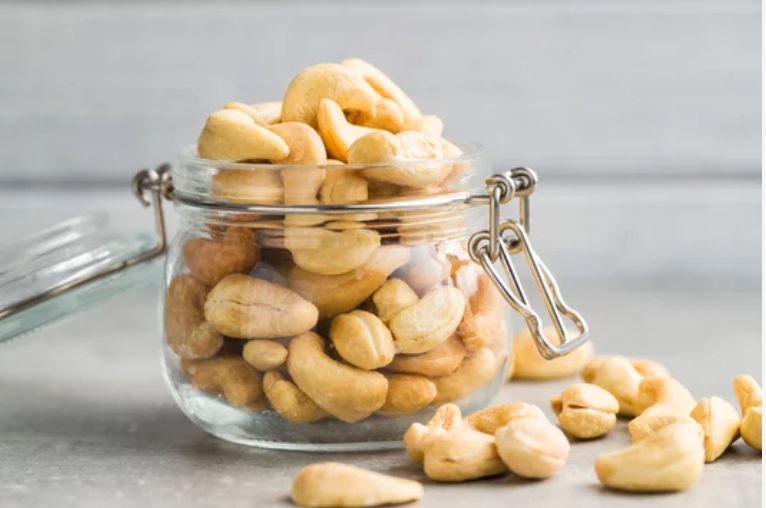Credit: Adobe Stock/ Jiri Hera
A recent study identified cashews as the most frequent cause of tree nut-induced anaphylaxis among children, with an increased rate from 2007 to 2024.1
“We observed a clear increasing rate of cashew-induced anaphylaxis among reported reactions to food,” wrote investigators, led by Veronika Höfer, from Charité – Universitätsmedizin in Berlin. “Cashew has been less widespread and relatively easy to avoid in the past. Today, cashew is much more frequently consumed, e.g., as snacks, in cooked meals, but also as vegan milk and meat substitute, and in pesto. The increased consumption likely affected increased sensitisation and reaction rates.”
The US Centers for Disease Control and Prevention (CDC) reported that the prevalence of food allergies has increased by 50% since the 1990s. About 33 million people in the US have food allergies, with many children allergic to shellfish (~8.4 million), milk (~6.2 million), peanuts (~6.2 million), tree nuts (~3.9 million), egg (~2.7 million), fin fish (~2.7 million), wheat (~2.4 million), soy (~1.9 million), and sesame (~ 0.7 million).2 Food allergies can be fear-inducing, isolating, and potentially life-threatening if they lead to anaphylaxis.3
When it comes to cashew-induced anaphylaxis, limited data existed. Investigators sought to identify phenotype-specific features among cases of tree-induced anaphylaxis, including age distributions, symptoms, severity, and potential cofactors and comorbidities.1 The team also aimed to analyze time trends and regional patterns of tree-induced anaphylaxis by examining the European Anaphylaxis Registry.
Investigators extracted cases of tree-nut anaphylaxis from 2007 to April 2024 from this anaphylaxis registry. They identified 1389 cases of tree-induced anaphylaxis out of 5945 (23%) registered food-induced reactions and included 1083 cases with confirmed elicitor status in the analysis. The sample included 845 children (median age, 4 years; 61% male) and 238 adults (mean age, 38 years; 40% male).
The most frequent triggers among children included cashew (n = 334; 40%), hazelnut (n = 211; 25%), and walnut (n = 146; 17%). Rates of cashew-induced anaphylaxis increased from 2007 to 2024, and reactions were caused by small amounts, < 1 teaspoon. Least common triggers included pistachio (8%), Brazil nut (3%), almond (3%), macadamia nut (1%), rare/unidentified tree nuts (1%), and pecan nut (1%).
The most common triggers for adults included hazelnut (n = 105; 44%), walnut (n = 47; 20%), and almond (n = 35; 15%). Anaphylaxis occurred at greater doses. The least common triggers among adults include Brazil nut (6%), cashew (5%), macadamia nut (4%), rare/unidentified nuts (4%), and pistachio (3%); pecan nut was not reported among adults.
Reaction severity was age-independent, and very few children (23%) and adults (21%) were previously aware of their allergy. Adrenaline use was low in lay treatment for children (13%) and adults (3%). Adrenaline was used in approximately 40% of cases during professional treatment.
Cashew-induced anaphylaxis occurred in 97% of pediatric cases, affecting mostly infants and young children < 5 years. Cashews rarely resulted in anaphylaxis in children > 10 years. Walnut-induced anaphylaxis also occurred more often in young children.
Hazelnut-induced anaphylaxis peaked during childhood and persisted throughout life. Almond-induced anaphylaxis and anaphylaxis to other tree nuts occurred throughout life but slightly more in childhood and young adulthood.
The most common comorbidities among children with tree nut-induced allergies were other food allergies (36%), atopic dermatitis (35%), asthma (27%), and allergic rhinitis (25%). Children with almond-induced anaphylaxis had frequently reported comorbid allergic rhinitis (59%) and asthma (41%).
Among adults, the most common comorbidities were allergic rhinitis (51%), asthma (21%), and other food allergies (16%). While non-atopic comorbidities were rare in children, they were common in adults, with several experiencing cardiovascular diseases and mastocytosis.
Potential cofactors were observed in 50% of adult patients and 17% of children. Exercise (15%) was the most frequent cofactor in children, and drugs (31%) and exercise (21%) were the most common in adults.
“Whether [tree nut-induced anaphylaxis] might become even more frequent in the future, as tree nut allergy is often persistent and tree nut consumption increases due to changes in eating habits towards plant-based protein sources, requires further monitoring,” investigators wrote. “Considering the large number of patients, it is crucial to improve the management.”
References
-
Höfer V, Dölle-Bierke S, Sabouraud-Leclerc D, et al. A Growing Concern for Cashew and an Unexpected Risk From Almonds: Data From the Anaphylaxis Registry. Allergy. Published online June 13, 2025. doi:10.1111/all.16619
-
Derman, C. Microbes, Medicine, Modern Life May Drive Food Allergy Rise, Experts Say. HCPLive. May 29, 2025. https://www.hcplive.com/view/microbes-medicine-modern-life-may-drive-food-allergy-rise-experts-say. Accessed July 21, 2025.
-
Derman, C. How to Address Food Allergy Anxiety with Proximity Challenges. HCPLive. May 30, 2025. https://www.hcplive.com/view/how-to-address-food-allergy-anxiety-proximity-challenges. Accessed July 21, 2025.
